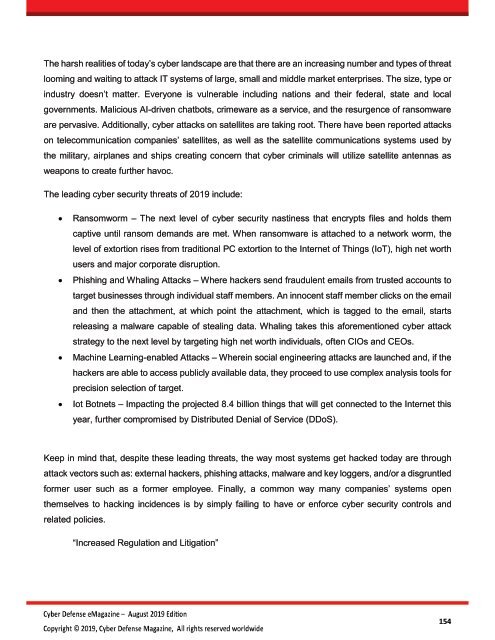Cyber Defense eMagazine August 2019
Cyber Defense eMagazine August Edition for 2019 #CDM #CYBERDEFENSEMAG @CyberDefenseMag by @Miliefsky a world-renowned cybersecurity expert and the Publisher of Cyber Defense Magazine as part of the Cyber Defense Media Group
Cyber Defense eMagazine August Edition for 2019 #CDM #CYBERDEFENSEMAG @CyberDefenseMag by @Miliefsky a world-renowned cybersecurity expert and the Publisher of Cyber Defense Magazine as part of the Cyber Defense Media Group
You also want an ePaper? Increase the reach of your titles
YUMPU automatically turns print PDFs into web optimized ePapers that Google loves.
The harsh realities of today’s cyber landscape are that there are an increasing number and types of threat<br />
looming and waiting to attack IT systems of large, small and middle market enterprises. The size, type or<br />
industry doesn’t matter. Everyone is vulnerable including nations and their federal, state and local<br />
governments. Malicious AI-driven chatbots, crimeware as a service, and the resurgence of ransomware<br />
are pervasive. Additionally, cyber attacks on satellites are taking root. There have been reported attacks<br />
on telecommunication companies’ satellites, as well as the satellite communications systems used by<br />
the military, airplanes and ships creating concern that cyber criminals will utilize satellite antennas as<br />
weapons to create further havoc.<br />
The leading cyber security threats of <strong>2019</strong> include:<br />
• Ransomworm – The next level of cyber security nastiness that encrypts files and holds them<br />
captive until ransom demands are met. When ransomware is attached to a network worm, the<br />
level of extortion rises from traditional PC extortion to the Internet of Things (IoT), high net worth<br />
users and major corporate disruption.<br />
• Phishing and Whaling Attacks – Where hackers send fraudulent emails from trusted accounts to<br />
target businesses through individual staff members. An innocent staff member clicks on the email<br />
and then the attachment, at which point the attachment, which is tagged to the email, starts<br />
releasing a malware capable of stealing data. Whaling takes this aforementioned cyber attack<br />
strategy to the next level by targeting high net worth individuals, often CIOs and CEOs.<br />
• Machine Learning-enabled Attacks – Wherein social engineering attacks are launched and, if the<br />
hackers are able to access publicly available data, they proceed to use complex analysis tools for<br />
precision selection of target.<br />
• Iot Botnets – Impacting the projected 8.4 billion things that will get connected to the Internet this<br />
year, further compromised by Distributed Denial of Service (DDoS).<br />
Keep in mind that, despite these leading threats, the way most systems get hacked today are through<br />
attack vectors such as: external hackers, phishing attacks, malware and key loggers, and/or a disgruntled<br />
former user such as a former employee. Finally, a common way many companies’ systems open<br />
themselves to hacking incidences is by simply failing to have or enforce cyber security controls and<br />
related policies.<br />
“Increased Regulation and Litigation”<br />
154


















